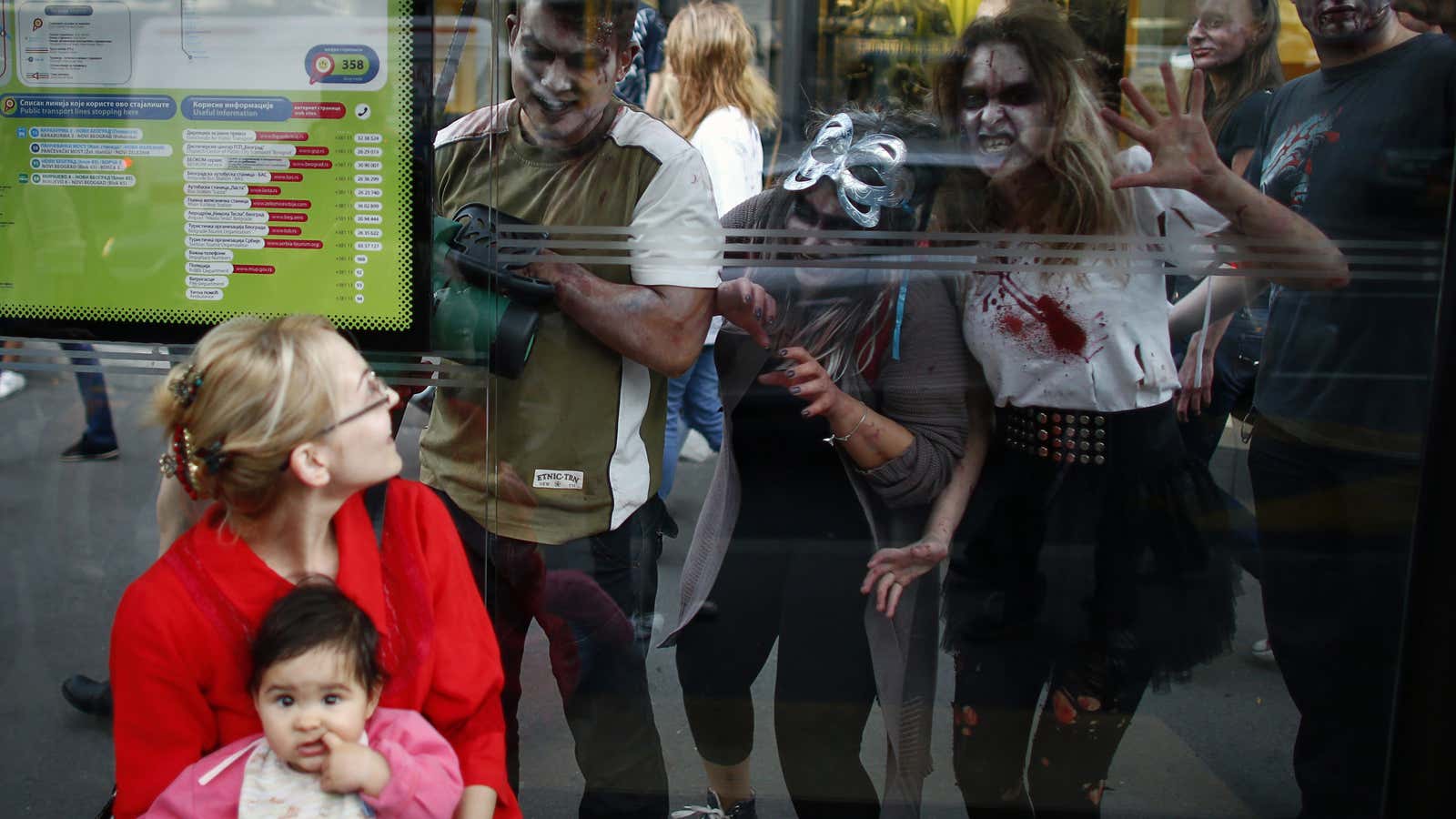I hate scary movies. Really, really hate them. I find even the most over-the-top, borderline-comedic scary films absolutely terrifying. It takes very little effort on the part of a film director to scare the wits out of me. I’ll jump at the flicker of shadows, my hairs raising at the faintest bar of sinister music.
This trait has been a great source of amusement for my friends and family over the years. One of my strongest memories of high school was reading a book under my friend’s pool table while my best friends watched Seven. More recently, I spent months polling people on where Get Out fell on the scale of “socially important” vs. “you will pee in your pants” before I finally watched it. I can’t even deal with so-bad-it’s-silly horror, having spent half of this year’s The Mummy reboot hiding behind a friend’s shoulder, making her detail how Tom Cruise was facing off against the dead.
Why do I—and so many other people—have such a hard time with horror? One theory is that some of us experience fear differently. Scaredy-cats’ brain chemistry just aren’t wired to enjoy the flood of hormones that accompanies terrifying but basically risk-free scenarios. (You won’t ever find me on a roller coaster, either.) It could also be that we’re hypersensitive and struggle to disassociate from the movies we watch. That means I only see a thin veil between horror and reality, one that is frequently punctured by tragic news events. When a stranger enters a house onscreen, I mentally count the locks on our front door. A shot rings out, an actor screams—my mind jumps to a real-life shooting.
But as much as the experience of watching a horror movie freaks me out, I’ve become increasingly convinced that I should commit to watching more of them this Halloween season—in the hopes that they may be able to help me get a better understanding of the world.
I moved to the US from South Africa nine years ago. There are many things I don’t understand about America: Its love of air conditioning; why strangers are always so nice; The Bachelor; pumpkin spice. And the longer I’ve lived here, the more I’ve come to realize that scary movies are an excellent way of understanding the society that produced them.
Is there anything more American than the Halloween series, which like Michael Myers, appears to never die? The character is a force of pure evil stalking suburbia—mirroring the vulnerabilities and fears of suburban Americans, and piercing the thin facade of normality in calm, quiet neighborhoods. The influence of horror classics like The Blair Witch Project, Psycho, Carrie, and The Shining is apparent throughout American culture, showing up in sitcoms, satire, video games, music videos, and books. There’s even an entire field of scholarly research called “Horror Studies,” devoted to explaining how scary movies reveal cultural attitudes toward everything from women’s rights to sex, consumerism, and race.
“Some horror classics are worth watching, not just because they’re scary but because they’re genuinely terrific films,” Adam Epstein, Quartz’s film and TV writer, tells me. “Horror fiction certainly didn’t start in America, but the American horror tradition is long and rich, starting perhaps with Edgar Allan Poe, who brought the Gothic genre to the US in the early nineteenth century.” My fear of scary movies means I’m missing out on a lot of cultural conversations—and on getting a closer look at America’s psyche.
Moreover, horror films can help us confront the less positive aspects of our society, as John S. Nelson suggests in Politics in Popular Movies: Rhetorical Takes on Horror, War, Thriller, and Sci-Fi Films. “In horror films, the evils of our times ease into the edges of our awareness under the cover of specific symbols,” Nelson writes. “Experiencing these evils in disguise, we can begin coming to realistic terms with their sources, dynamics, and effects.”
In Get Out, for example, director Jordan Peele deftly confronts viewers with the realities of white ignorance and black anxiety, surfacing and acknowledging feelings that are an undercurrent of an American life. The film taps into the idea that “even the most delusional white person can no longer credibly strike a pose of white racial innocence,” as Rich Benjamin writes in the New Yorker.
I want to experience these cultural conversations as my friends do. And by bowing out, I’m also missing out on the “ultimate communal cinematic experience” that comes with watching a horror film with family and friends, Epstein says.
“It’s one of only a few experiences we know of where you can really get your adrenaline going, yet know that you’re still completely safe,” he says. “Research shows that deep down, we like to be frightened. Younger people tend to seek out intense, thrilling experiences—an impulse that usually fades with age. So now’s the time to get into the horror genre, especially since we’re in the middle of what you might call a scary movie renaissance.”
So this Halloween season, I’m making a commitment to push myself a little to watch my husband’s favorite horror movie, The Shining. I’ll be consulting this WikiHow guide on “How to Watch a Horror Movie” for tips like watching from inside a pillow fort, and saying to myself, “This is not real!” Perhaps my husband will find solace in this LifeHacker guide, “How to Watch Movies with Someone Who’s a Total Weenie.” And all the while, I’ll be thinking of the king of horror himself, Stephen King, who once said: “We make up horrors to help us cope with the real ones.”
